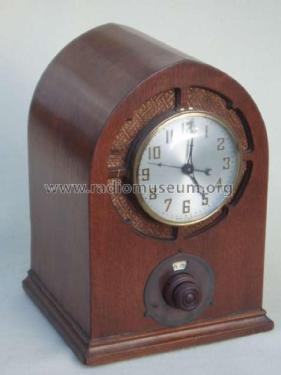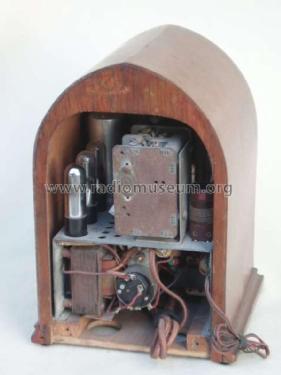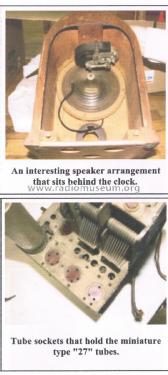Tiny-Tube AC Loudspeaker Set Model 8
Radio Products Corporation; Newark and Hoboken, NJ
- Country
- United States of America (USA)
- Manufacturer / Brand
- Radio Products Corporation; Newark and Hoboken, NJ
- Year
- 1932
- Category
- Broadcast Receiver - or past WW2 Tuner
- Radiomuseum.org ID
- 52642
Click on the schematic thumbnail to request the schematic as a free document.
- Number of Tubes
- 0
- Number of Transistors
- 6
- Semiconductors
- Main principle
- TRF without regeneration
- Wave bands
- Broadcast only (MW).
- Power type and voltage
- Alternating Current supply (AC) / 110 Volt
- Loudspeaker
- -Loudspeaker incorporated, but system not known.
- Material
- Wooden case
- from Radiomuseum.org
- Model: Tiny-Tube AC Loudspeaker Set Model 8 - Radio Products Corporation;
- Shape
- Table-Cathedral-Type (upright, round top or gothic arch, not rounded edges only).
- Dimensions (WHD)
- 10 x 10.5 x 6.5 inch / 254 x 267 x 165 mm
- Notes
-
This radio is very small and is equipped with specially made minature no. 27 tubes.
The loudspeaker surrounds the back of the clock face and is of the "Rochelle Salt Reproducer" design. The speaker is described in the July 1932 issue of Radio Craft.
- Net weight (2.2 lb = 1 kg)
- 14 lb 0 oz (14 lb) / 6.356 kg
- Price in first year of sale
- 17.50 $
- Source of data
- Radio Collector`s Guide 1921-1932
- Mentioned in
- Radio Craft (August 1932, pages 82-83)
- Author
- Model page created by Peter Rutishauser. See "Data change" for further contributors.
- Other Models
-
Here you find 2 models, 1 with images and 2 with schematics for wireless sets etc. In French: TSF for Télégraphie sans fil.
All listed radios etc. from Radio Products Corporation; Newark and Hoboken, NJ
Collections
The model Tiny-Tube AC Loudspeaker Set is part of the collections of the following members.
Forum contributions about this model: Radio Products: Tiny-Tube AC Loudspeaker Set Model 8
Threads: 1 | Posts: 2
The Radio Products Company's clock radio was first advertised in Hahne's Department Store, Newark, New Jersey on August 9th, 1932. This radio had small parts and small tubes. The company has a very interesting history and this has been documented in various historical radio society magazines. The article in "Radio Age" (Mid Atlantic Radio Club), July 1990 by Alan Douglas is used as the main reference and permission is acknowleged.
For many years radio designers had been trying to build smaller sets. Using smaller compnents, or fewer were two ideas. By 1930 radio circuits were fairly standardized - two stages of TRF amplification, a detector and two or more stages to drive a loud apeaker. These also included a power supply and rectifier tube. The design of "cathedral" or tombstone mantel radios of the day was becoming common, but power supplies and loud speakers were not small.
In mid 1931 Harry van Deventer (formerly of Westinghouse, Dubilier and General Motors) and Earl Koch (formerly many years with Kellogg) formed the Patent Engineering Corporation and were principals of this concern. Koch had the idea that a tube could be made with small dimensions and that a radio with six of these tubes could fit into a mantel clock base. A clock manufacturer, Ardle Bulova, was particularly interested in the idea. They had sold many hundreds of clock radios (radios with clocks in them) but wanted a radio inside a clock.
In August 1931 Patent Engineering approached the National Company with the idea of manufacturing this tiny radio. As far as tubes were concerned, the Hy-Grade Lamp Company of Salem, Massachusetts, was approached to make the new tubes. Hand made samples of the tube, made by Koch did not work and by September 3rd, Hy-Grade withdrew their support. Twelve days later National apparently withdrew as well.
in developing the radio, van Deventer and Koch applied for several patents and these included a few on the unusual tube. the radio's concept included the most unusual design of the Rochelle-Salt loud speaker, which was made by the Brush Development Corporation of Cleveland, Ohio (for a complete description of this speaker, please see the July 1932 issue of "Radio Craft" - "The Rochelle-Salt Reproducer"). The diaphragm of this was to extend around the entire inside of the cabinet, to provide good surface area for good bass response. This speaker was crystal operated and placing the crystal in various positions inside the cabinet caused concern for some months. Also the crystal had the problem of distorting when voltage was applied. A new chassis layout was designed and a totally new radio, with newly designed tubes was announced in July 1932.
This announcement was preceded by more experiments and in particular with tubes. A manufacturer of tube machinery and parts (name not recorded) had James V Capicotto as an engineer who worked with van Deventer at Dubilier in 1924. He applied for a patent on a tube similar in design to the UY227 but much smaller. US patents 1817772 and 1817333 apparently relate to these but have not been located on the internet..There were six tubes in the radio - five triodes and a mercury vapor rectifier. The triodes have a smaller version of the UY pin assembly and the rectifier has a three pin base, the same diameter. According to one circuit diagram located, the triodes were given the type number 101 and the rectifier R10. The crystal speaker had been replaced by a balanced armature driver connected to celluloid cone in the clock.
Capicotto wrote an aritcle in "Radio Craft' August 1932 entitled "A Tiny-tube A.C. Loud Speaker Set". However, there was nothing like this clock radio on the market and it should have sold well. Radio Products Co. vanished from public view and and was defunct by 1934.
A few clock radios have survived and one is mentioned in "The Jersey Broadcaster", page 3, May 2014 and there is a short article on the website www uv201a.com on the tubes. A circuit diagram for an 8 tube set has been recently located which shows a type 100 in the tube line up (possibly a detector) and this tube is being further researched.
Fin Stewart, 23.Jul.20







